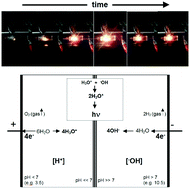当前位置:
X-MOL 学术
›
J. Mater. Chem. C
›
论文详情
Our official English website, www.x-mol.net, welcomes your
feedback! (Note: you will need to create a separate account there.)
Electrically induced light emission from proton-conducting materials. Protonic light-emitting diodes
Journal of Materials Chemistry C ( IF 5.7 ) Pub Date : 2019-12-20 , DOI: 10.1039/c9tc05980f Jerzy J. Langer 1, 2, 3, 4, 5 , Ewelina Frąckowiak 1, 2, 3, 4, 5 , Sebastian Golczak 1, 2, 3, 4, 5
Journal of Materials Chemistry C ( IF 5.7 ) Pub Date : 2019-12-20 , DOI: 10.1039/c9tc05980f Jerzy J. Langer 1, 2, 3, 4, 5 , Ewelina Frąckowiak 1, 2, 3, 4, 5 , Sebastian Golczak 1, 2, 3, 4, 5
Affiliation

|
Water doped with H+ and HO− enables the formation of a protonic p–n junction, which works similarly to a typical, electron-based p–n junction, including light emission when electrically powered. In the model examined, polymer scaffolding maintains the mechanical stability of the water-based system, and at the same time the side groups (acidic or basic) play the role of dopants, creating a stable proton gradient system. The chemically generated proton gradient system (protonic p–n junction) emits light owing to the proton current flow when the device is electrically powered. The results of experiments not only demonstrate the crucial role of protons in the light emission processes (the system with a protonic p–n junction), but also open the new way for light generation with proton-conducting materials (proton-based light emitting diodes, protonic LEDs).
中文翻译:

质子传导材料的电感应光发射。质子发光二极管
水掺^ h +和HO -能够形成质子pn结,其与典型的基于电子的pn结相似,包括通电时的发光。在所研究的模型中,聚合物支架可维持水基体系的机械稳定性,同时侧基(酸性或碱性)起掺杂剂的作用,从而形成稳定的质子梯度体系。当设备通电时,由于质子电流的流动,化学产生的质子梯度系统(质子PN结)发光。实验结果不仅证明了质子在发光过程(具有质子p–n结的系统)中的关键作用,而且为质子传导材料(基于质子的发光二极管)的光产生开辟了新途径。 ,质子的LED)。
更新日期:2020-01-08
中文翻译:

质子传导材料的电感应光发射。质子发光二极管
水掺^ h +和HO -能够形成质子pn结,其与典型的基于电子的pn结相似,包括通电时的发光。在所研究的模型中,聚合物支架可维持水基体系的机械稳定性,同时侧基(酸性或碱性)起掺杂剂的作用,从而形成稳定的质子梯度体系。当设备通电时,由于质子电流的流动,化学产生的质子梯度系统(质子PN结)发光。实验结果不仅证明了质子在发光过程(具有质子p–n结的系统)中的关键作用,而且为质子传导材料(基于质子的发光二极管)的光产生开辟了新途径。 ,质子的LED)。











































 京公网安备 11010802027423号
京公网安备 11010802027423号